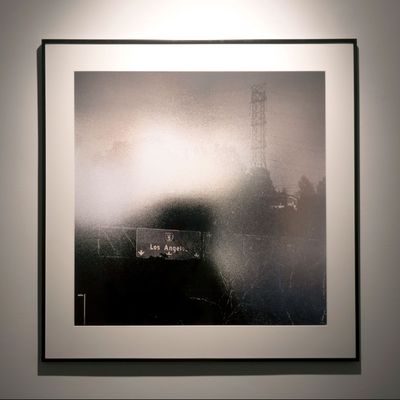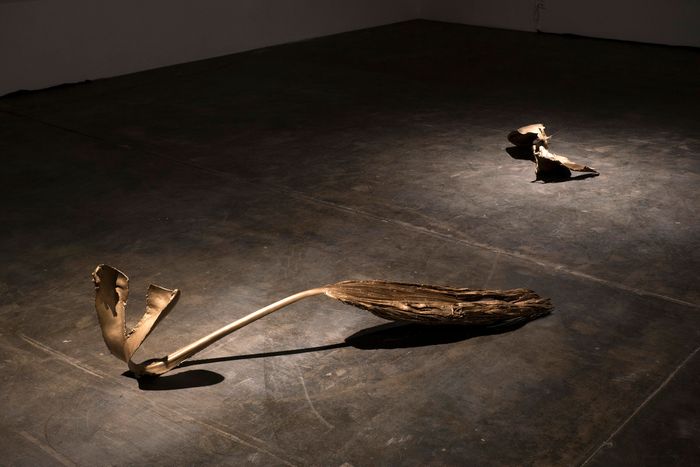
The allure of Los Angeles has long-balanced on the razor’s edge between fantasy and reality, but lately, with the wildfires and the mudslides and the dying off of the city’s trademark palm trees — most of which weren’t native anyway — and, now, even more deadly conflagrations that have turned fall rainy season into fire season, it’s become a bit too real.
Zoe Crosher, who was born in Santa Rosa, California (but grew up abroad the daughter of diplomat), moved to L.A. to get her MFA at CalArts in the early aughts. She’s been mining the vein of this liminal space between the image of L.A. and the actual place in photographic (and sculptural) bodies of work inspired by everything from the fiction of Eve Babitz, the reclusive L.A. writer who has lately had a bit of a comeback, to the decline of the palm tree and the Los Angeles River. Crosher, who was a standout of the New Photography 2012 survey at MoMA for the Michelle duBois Project , again draws on this trio of utterly Angeleno influences for Sunlight As Spotlight, her solo debut at the Bergamot Station gallery of Patrick Painter, which features four 48-by-72-inch light boxes of images shot using the silent-film-era technique known as “day for night” to capture what climate change and environmental management has left of the L.A. River.
But last weekend, Crosher’s artist talk, which was supposed to begin with a reading from Babitz’s Slow Days, Fast Company, was nearly canceled (only a few folks made it out) amid the chaos of the Woolsey Fire. In a sense, the world had quite literally caught up to Crosher’s investigations.
Day for night “was done during the old days of film when they didn’t have money to shoot at night, so they used all these crazy filtration systems to make it look like day, so you have all these beautiful hiccups in film noir where you’ll see clouds in the sky at night and things that just don’t make sense,” says Crosher. She merged these analogue techniques with digital photography to create work that not only comments on the death of the river — including the attendant palm trees, one of which is captured sans crown like a beheaded sentry — but on the slow creep of global warming, water politics, star culture, and westward expansion. Her images use surface and tricks of light, exposing the cracks in the veneer of this idyllic L.A., to probe deeper into the dark realities that lie just beneath that surface.
On the floors of the gallery are bronzed palm fronds, which were found on the sides of L.A. streets and freeways then transformed into sculptures using lost wax casting. (This L.A. icon — varieties that were mostly imported from elsewhere — are being killed off by fungus and invasive insects. Instead of replacing them with new palms, the city has chosen trees that tolerate drought better and provide more shade.) Crosher’s casts serve as a “pre-archiving of the death of Los Angeles” that document the demise of this outmoded emblem of the L.A. fantasy.
“The actual palm frond is covered in wax then covered in concrete, and then it gets burned out and filled with bronze, and in a photographic sense that is really exciting because the bronze becomes the palm frond,” explains Crosher. “It’s beyond anything photographic, it’s basically what photography only ever wishes it could be in terms of archiving. No matter how close I photograph L.A., I can never get it this close.”
The metaphor of a dried-out palm frond being consumed by molten bronze is not — or perhaps should not — be lost in this moment when President Trump is falsely accusing the Bureau of Land Management, not climate change (much less art-washing water hoarders) for causing these fires. All the creative-class chieftains flooding social media with neoromantic devastation-porn images of the fires in Malibu and Ventura County, might do themselves a favor by having a quiet meditation among Crosher’s erie, if razor-sharp, “pre-archival” relics.
This is the Babitz excerpt she’d planned to read:
Ever since the Garden of Allah was torn down and supplanted by a respectable savings and loan institution, the furies and ghosts have made their way across Sunset to the Chateau Marmont. The Garden of Allah was originally the villa of Alla Nazimova, a great silent star, until one night when a fire swept down Laurel Canyon, and she was forced to decide what she wanted to save from her grand house — what, in fact, she wanted at all. And she suddenly knew that the flames could consume all she owned, she would leave for New York at once; there was no point in owning anything in Hollywood, and in this she had a curious premonition or grasp of “place.” It’s a morality tale of the unimportance of material things, though there are those who will say it’s about how awful L.A. is.
“I didn’t need to read it, it was already happening,” says Crosher, who notes that her work has been “plotting this [reality] for so long, it’s been this slow accumulation of all these various elements that have to do with my troubled love affair with Los Angeles.”
And in the end, “I’m really proud of the show, but it was really like the end is nigh, and it was a little too close; there was not enough distance. That’s why I’m back in New York. Bring on the snow,” says Crosher, who recently moved to Brooklyn after two decades in Los Angeles, and left the city two days early amid the flames. “I can handle the fantasy; I can handle the end of the fantasy — when I’m far away from it.”
Meanwhile, on Friday morning, a brush fire broke out in the Hollywood Hills, though it was quickly put out before threatening any homes. This time.


